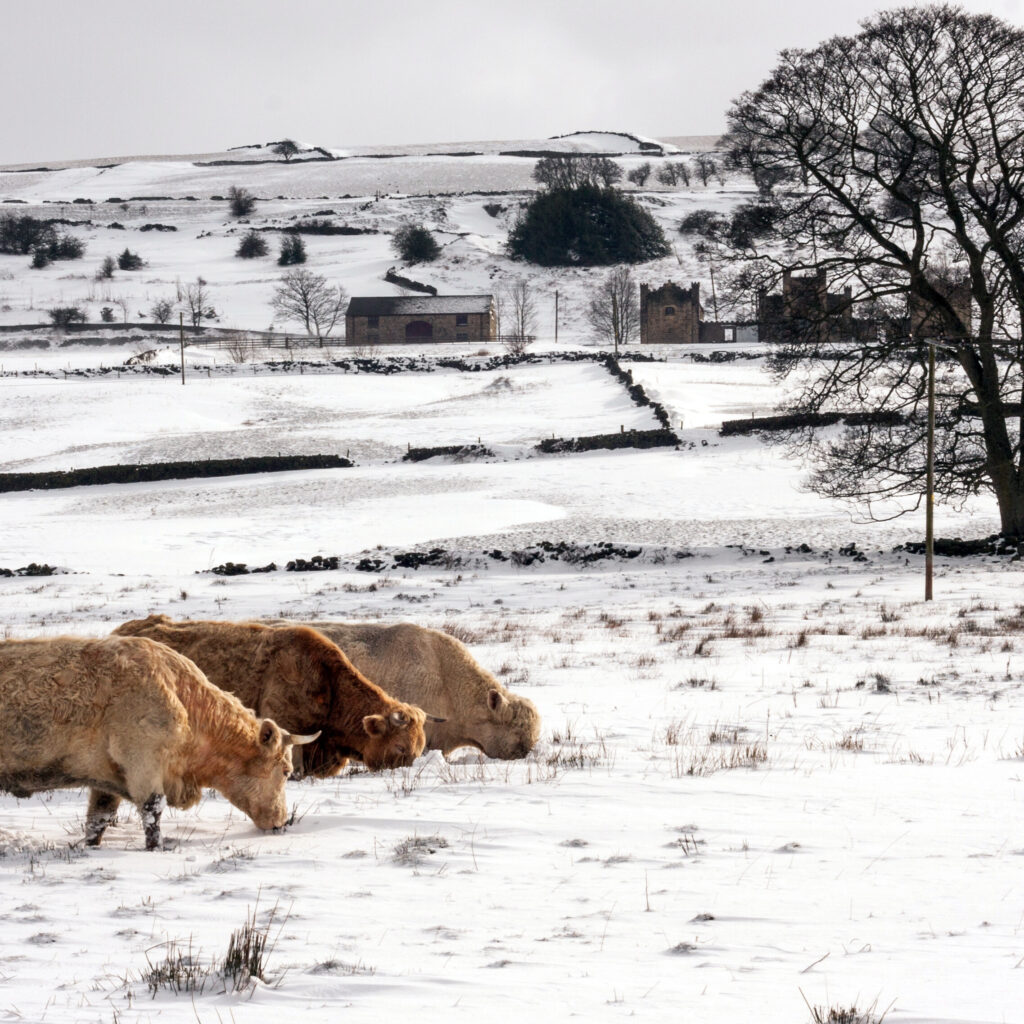
Termination

Methods detailed below will support the reduction of the use of glyphosate, but it still would be needed at some stages of termination.
Methods of cover crop destruction vary considerably and will depend on the interaction of soil type, cover crop choice and the following crop’s intended sowing system (e.g., the drill type to be used). Discs are typically better at dealing with residue from cover crops than tines, but both can work when set-up well. Terminating a cover crop very early (i.e. pre-Christmas) will give the longest time for the cover crop residue to die back and allow easier drilling/cultivating at the required time in spring, though for cover crops grown under countryside stewardship or SFI options termination timing needs to be within the specific rules of that agreement.
Below are pointers on different destruction methods, but there is still an amount of trial and error in how to achieve good results. Generally, you should be looking to destroy cover crops relatively far ahead of the following crop, unless ‘drilling on the green’, but there are several points to consider around destruction timing. The most often cited rule of thumb is to destroy a cover crop 6-8 weeks prior to the intended drilling date of the following crop to avoid a yield penalty.
Soil moisture levels for the following crop are also an important consideration for termination timing, as it takes land longer to dry under a cover crop canopy. Generally light/medium soils are more forgiving, but this can lead to wet soil persisting into spring on heavier land, delaying drilling where cover crops are used. Consequently, it may be beneficial to terminate cover crops earlier on heavy soils to provide extra time for surface drying, particularly in very rigorous cover crops which create a dense, wet canopy.
Weed pressure may also inform termination plans. Blackgrass, for example, can be a difficult target to hit under a dense cover crop. Here, methods such as a light grazing or crimper rolling can be used to destroy the bulk of the cover crop so that glyphosate can more effectively hit the blackgrass which is shaded underneath.
Choosing a cover crop planting date is a critically important management decision. The earlier they are planted in August their biomass production increases significantly.

Figure 1 shows a cover crop mix of phacelia and black oat planted at three dates mid August, end of August and mid September and subsequently terminated at the end of November, January and March. Both planting dates and termination dates significantly increase biomass, however planting dates have a far greater benefit. Biomass production if essential to drive many of the key benefits of cover crops such as soil structure improvements and soil biology.
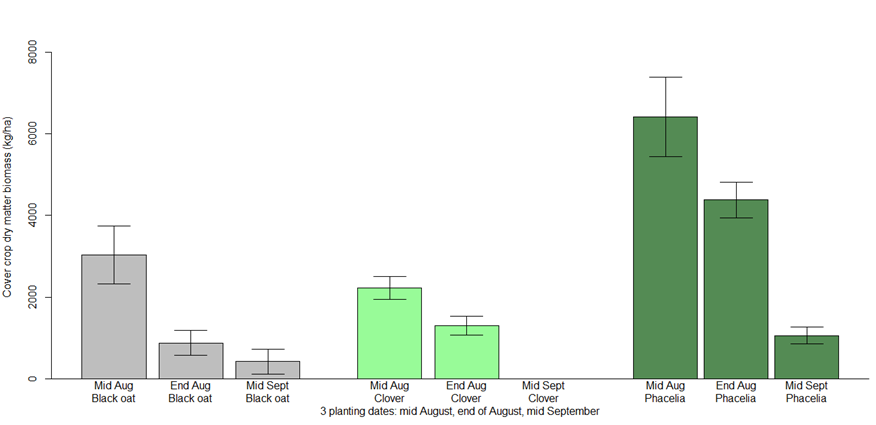
(Copyright: David Purdy Soils)
Figure 2 shows the individual effects of planting dates on three individual species, all terminated in December, Phacelia, black oat and clover again planting dates are critical for biomass and production with mid September dates showing very low production.
Weather
When designing a cover crop mix of species, it may well be advantageous to include species that are frost tolerant, especially when cover cropping on heavy land that may be difficult to traffic on for other termination approaches, or where labour issues may restrict the ability to terminate the cover crop.
Care should be taken to ensure frost sensitivity where temperature is used for termination, as whilst some cover crop species such as buckwheat are reliably killed by frost, frost sensitivity in others (such as Phacelia) may vary depending on the genetics on the seed used.
(Image: David Purdy Soils)
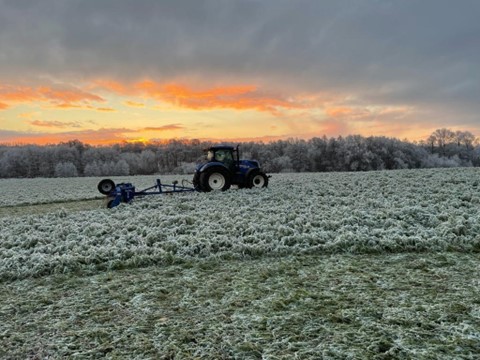
Machinery Based
Rolling/crimping for cover crop termination tends to work best in the UK when there is a frost, and can have very good results on larger plant species. As a general rule it does not perform as well to terminate grasses, such as cereals, brome or blackgrass, where these will typically need an application of glyphosate.
According to Innovative Farmer trials, a temperature of -4oC at the time of rolling is generally required to achieve termination, and preferably for several days prior to rolling in order to shatter the stems. This delivers two things – frost penetration right into the whole of the cover crop, and a well frozen soil profile to avoid putting compaction into the land.
Best results are also typically achieved if rolling can be actioned early in the morning (between 2am and 7am, depending on time of year) as frosts tend to be heaviest before sunrise.
The ground needs to be frozen to take the weight of the machinery to reduce the compaction.
(Image: David Purdy Soils)
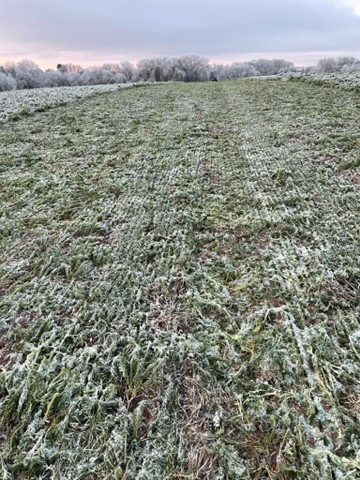
Grazing
Grazing by sheep is favoured by some for its role in cover crop termination and is often referred to as the ‘golden hoof’ treatment. Cattle are also worth considering, but have the potential to poach the land more than sheep due to the extra weight. It should nevertheless be noted, particularly on heavy soils, that grazing in any form needs to be ‘fleet of foot’. Poaching can occur in a surprisingly short space of time, so soil conditions and weather (risk of run off) should be assessed continually to ensure conditions are suitable for grazing.
(Image: Angus Gowthorpe, Approach Farm)
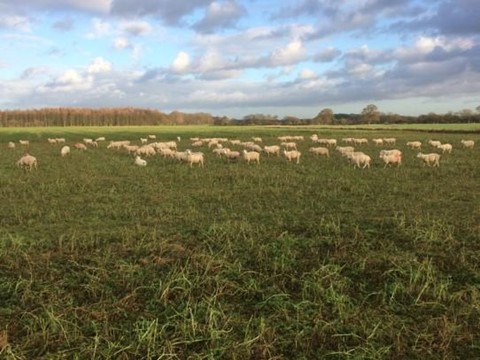
When well managed, livestock can do a fantastic job of reducing the bulk of a cover crop and have the additional benefit of starting the process of breaking down organic matter. They also provide income from the grazing, either as meat to sell or through grazing payments, as well as giving the graziers grass a rest from grazing. However, several important points should be remembered when bringing livestock onto arable farms:
- A manure management plan MUST be in place, calculating the Livestock Manure Nitrogen Farm Limit. This must be prepared when any livestock are brought onto a holding, including a risk map showing all watercourses and no spread zones.
- The ‘deposited’ manure from the grazing livestock does not need to be taken into account in the following crop’s NMax. This is partly due to not being able to substantiate how much is actually available to the crop. It is also typically going to be a relatively low figure in terms of spring crop nitrogen allowance, with high probability that the distribution of manure across the field is uneven. This deposition figure does, however, need to be calculated within the livestock manure plan calculations.
- Allow time after grazing livestock for the cover crop to ‘green up’ to enable it to be sprayed off prior to drilling.
- Consider using a strip till drill rather than a disc direct drill which means you take out the compaction in the top 2 inches.
- Some linseed contains products which may produce cyanide. This can be released when grazed and can be toxic to animals. Please seek professional advice when selecting this species in reference to its suitability for grazing.
- Buckwheat in a high concentration can be toxic to livestock. OK in a species mix.
Chemical termination
Use of herbicide is the most typical route for cover crop destruction and certainly provides the best and most reliable total control. Chemical termination revolves around glyphosate, either alone or with the addition of carfentrazone (Shark) or 2,4-D (Kyleo).
In all cases, beware of following crop drilling interval requirements.
Where cover crops are being used to help manage pernicious weeds, eg blackgrass, or include brassicas within the mixture, more than one glyphosate application may be needed – one to terminate the ‘upper canopy’ and then another pre cultivation/drilling to kill the ‘under canopy’ of weed species.
(Image: Yorkshire Agricultural Society / Simon Hill Photography)

Particular attention should also be given to chemical cover crop destruction in front of broad leaf crops, because the herbicides available ‘in crop’ may not cover wide weed spectrums, or indeed be able to target the cover crop species themselves if initial destruction isn’t completely successful. Generally, the earlier the cover crop is sprayed off the better the results, as there is less residue to interfere with the drill/cultivator. Early termination also reduces issues with allelopathy and nitrogen lock up from the cover crop. A good aim is to spray 6 – 8 weeks ahead of drilling leaving plenty of time for a follow-up spray application.
If a crop has been grazed pre-glyphosate application, it is advisable to ensure adequate regrowth has taken place to actually take up the herbicide on application. Cover crops will generally need at least 3l/ha of 360g glyphosate, though higher rates/loadings may be beneficial for faster control or to terminate bigger cover crop stands.

Terminating late and drilling in the green
Late termination of covers crops would include anything terminated within six weeks of planting the cash crops. There would be a strong possibility of negative yield effects on the following crop.
The mechanisms, not fully understood currently, as to why this happens include nutrient lockup especially nitrogen as the cover crop residue breaks down, localized acid production created by soil biology breaking down the residue and finally negative effects on drilling the cash crop as they leave the soil wetter causing machinery to operate less effectively, this is more likely on heavier soils. Therefore, the recommendation is to terminate cover crops a minimum of 6 weeks prior to drilling.

Carbon to nitrogen ratio's
The carbon to nitrogen (C:N) ratio of the residues is one of the main factors influencing the dynamics of mineralisation of the nitrogen accumulated by the cover crops.
It is often thought that at a certain point of termination some grass species will have a high carbon to nitrogen ratio (C:N), however, cover crops are rarely taken to maturity and terminated typically 4 months after establishment while the plants are green.


